The Monomelt Company was known primarily for its "Monomelt System" of hot metal feeders (the subject of this present Notebook). It made other products, however, and these are best treated in their own areas. Here's a list of pointers to other Monomelt material at CircuitousRoot.
The Curle Matrix Anvil: ../../../ Composing Linecasters -> Literature for Linecasters -> Monomelt (except Monomelt); Curle.
Monomelt Company parts and attachments for Miller and other printer's saws: ../../../ Composing Room Equipment -> The Printer's Saw -> Monomelt Parts and Attachments.
The Monomelt Dross Sifter. It could be argued that the Dross Sifter is a part of the Monomelt System, but as it could be used with any style of metal feeding I've treated it separately in: ../../../ Common Casting Equipment -> Remelting Equipment -> Dross Handling and Processing -> Monomelt Co. Dross Handling Products.
[TO DO] Monomelt hoods from William Reid Co. 1931 catalog
George L. Curle held the basic Monomelt System patent (1,473,083, see below) and patents for some of the devices noted above. In addition, he held patents for the following devices which have a strong Monomelt connection (but which may or may not - I'm not yet sure - have been manufactured):
A "pot puddler" (agitator). See: ../ Metal Feeders -> Curle Pot Puddler (US patent 1,669,456 (1928)).
A waste material catching system, covered in three patents. See: Surveys: Type Processes and Machinery -> Introduction II: Surveys of the Equipment -> Composing Linecasters -> Third-Party Features -> Waste Material Catching:
Curle was quite inventive, and held patents for other hot metal equipment as well, including:
A multi-line matrix holding galley for matrix cleaning ../../../ Composing Linecasters -> Literature for Composing Linecasters -> Devices of Unknown Manufacture -> Curle Matrix Galley. This device was manufactured (I have an incomplete one), though I do not yet know who made it.
A magazine rack. See: Surveys: Type Processes and Machinery -> Introduction II: Surveys of the Equipment -> Composing Linecasters -> Third-Party Accessories -> Magazine Racks -> US Patent 1,759,688 (1930).
A tool for putting spacebands in and taking them out. See: Surveys: Type Processes and Machinery -> Introduction II: Surveys of the Equipment -> Composing Linecasters -> Third-Party Accessories -> Magazine Racks -> US Patent 2,583,324 (1952).
Devices for wiping and lubricating the side trimming knives in the knife block of a linecaster. See: Surveys: Type Processes and Machinery -> Introduction II: Surveys of the Equipment -> Composing Linecasters -> Third-Party Features -> Devices for the Trimming Knives:
A portable printer's saw. See: Surveys: Type Processes and Machinery -> Introduction II: Surveys of the Equipment -> Composing Room Equipment -> The Printer's Saw -> Portable Printer's Saws -> US Patent 1,662,638. Slug Sawing Device.
A device for casting italic type from slanting matrices on Linotype or Intertype linecasters. See: Surveys: Type Processes and Machinery -> Introduction II: Surveys of the Equipment -> Composing Linecasters -> Third-Party Features -> Unusual Casting Devices -> US Patent 1,427,363 (1922).
The Monomelt is a a hot metal feeder, not a cold metal feeder. That is, where a conventional "cold metal" feeder such as the Margach feeds pre-made solid ingots of typemetal into the pot, the Monomelt combines the functions of a remelting furnace and metal feeder by accepting slugs into itself, melting them, and delivering them as hot liquid typemetal into the pot. This method of course removes the expense and time of a separate remelting operation, and (it seems to me) eliminates the issue of chilling the pot with cold metal, but begs the question of metal alloy constancy. In most remelting and alloying operations, the general concensus is that larger batches reduce the variation of constituents in the alloy. Nevertheless, it is well spoken of in the literature (see the References section below).
I find it interesting that the innovation claimed in the basic "Monomelt" patent of 1923 is not the provision of an auxiliary melting pot (these were apparently well known at the time) but the combination of an auxiliary melting pot into a single unit with the main Linotype melting pot. I wonder - and it is nothing more than a guess - if this might not be the origin of the name "Monomelt" (a single - "mono" - unit)?
As is apparent in the 1939 catalog/parts list for the Model AMG, the "Monomelt System" is in fact a (small, but) complete system rather than just a feeder. In addition to the feeder itself, the system includes various articles of cabinetry for collecting slugs in a manner convenient for feeding the Monomelt. These include operator's cabinets (for collecting slugs right at the machine), "killout" cabinets (for gathering dead matter), and slug storage cabinets. All of these are compartmentalized in such a way that the slugs end up in convenient Monomelt scoops ready for delivery into the feeder.
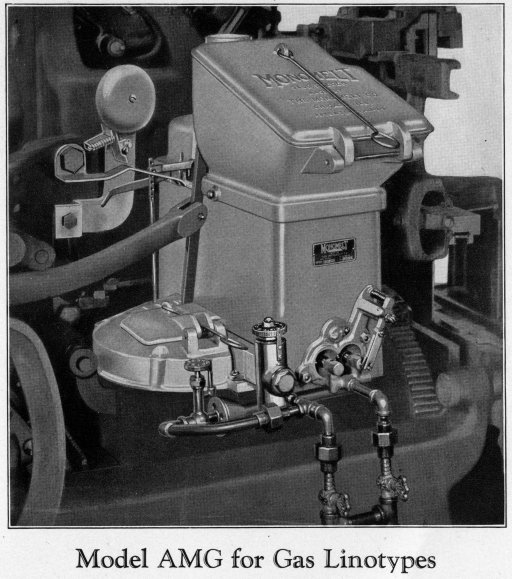

Parts List[,] Model AMG Used on Gas Linotypes
1939-10-16. In addition to showing the Monomelt as used on Linotypes, this manual illustrates the Monomelt "system" of scoops and cabinets and (by chance as much as anything else) also shows an example of a Monomelt installed on a Ludlow Typograph Machine.
The Monomelt "System" included a range of cabinets to hold scoops for collecting slugs. These included "killout" cabinets (the first illustration below), convenient cabinets and stands for operators of Linotypes and other machines, slug storage cabinets, and even a scoop attachment for the Miller Saw-Trimmer to catch typemetal swarf directly (third illustration below). These illustrations come from the 1939 Parts List, Model AMG Used on Gas Linotypes, above. The system is in part described in the US patent 2,0668,004 (George L. Curle and William H. F. Thompson, 1930/1937); see below.



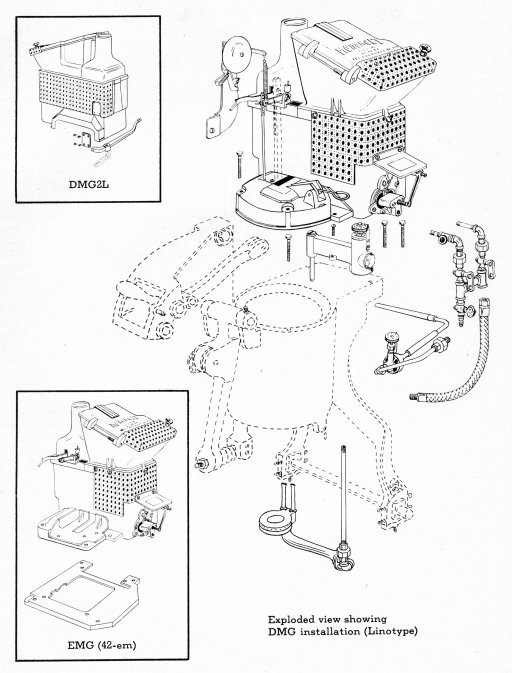
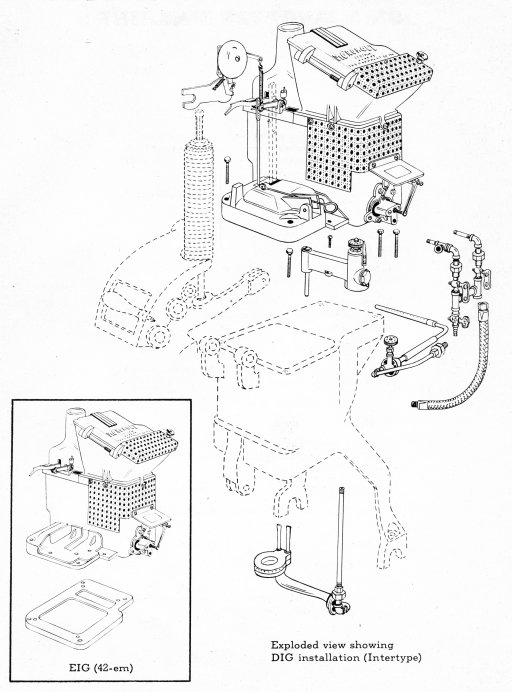
Manual and Parts List for Gas Monomelt for Linotype and Intertype Machines
No date.

(Below:) From the Mergenthaler Linotype Company's "Catalog No. 56" Linotype Accesssories and Supplies (No date, but probably the 1950s. Printing code: 741.56-H-UU-41.5X")
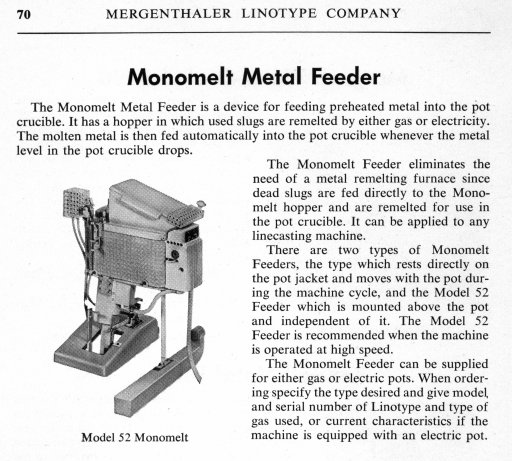
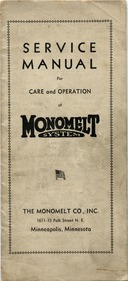
Service Manual (1943)
Service Manual for Care and Operation of Monomelt System. (Minneapolis, MN: The Monomelt Co., Inc., 1943). Dated 1943-07-01.
The icon here links to a presentation of this manual at The Internet Archive. Here is a local copy of the PDF (60 Megabyes): monomelt-service-manual-1943-07-01-linofish-0600dpijpg.pdf
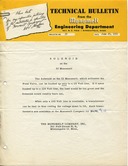
Technical Bulletin No. 30 (Solenoid)
Solenoid on the 52 Monomelt. Technical Bulletin No. 30. (June 29, 1953).
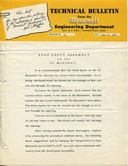
Technical Bulletin No. 31 (Feed Spout)
Feed Spout Assembly on the 52 Monomelt. Technical Bulletin No. 31. (June 29, 1953).
Here are some photographs of the Monomelt that came with my Elrod Strip-Casting Machine. It's huge. I haven't measured it, but it must hold the better part of a cubic foot of typemetal. Unfortunately, its nameplate had been removed prior to my acquisition of it, so I have no idea what model it is. As shown here, I've merely placed it back on top of its supporting column. I haven't yet hooked up any gas supply or regulation for it, or the feedback from the Elrod pot that I assume must have existed. It may be missing parts.
The first photo shows it swung back, clear of the Elrod crucible. The second photo shows it in feeding position over the Elrod crucible.

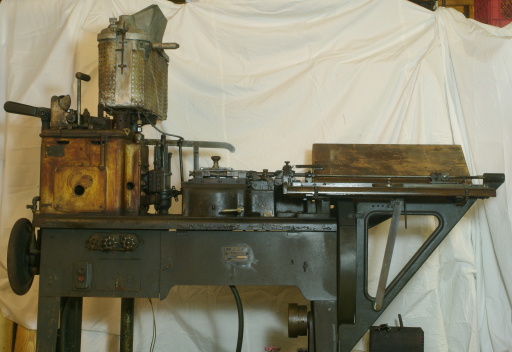
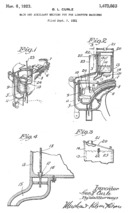
US 1,473,083. Curle. 1923. Monomelt, Basic Patent
George L. Curle. Filed 1921-09-03. Issued 1923-11-06. Not assigned at issue. "Main and Auxiliary Melting Pot for Linotype Machines." This is the basic "Monomelt" patent. Its innovation is the unification of an auxiliary melting pot and the main Linotype melting pot into a single unit. (Some later Monomelt brand devices of course separated them once again.) I find it interesting that he does not claim this as the first auxiliary pot, but rather as the first auxiliary pot combined into a single unit with the main Linotype pot. Perhaps this is the origin of the name "MONOmelt"?
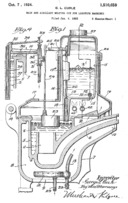
US 1,510,659. Curle. 1924. Monomelt, Refined
George L. Curle. Filed 1923-01-06. Issued 1924-10-07. Not assigned at issue. "Main and Auxiliary Melting Pot for Linotype Machines." This is a refinement of Curle's 1923 patent. It shows a device very much like the Monomelt as produced, with a feeding valve controlled by a float in the main pot, and gas regulation thermostatically controlled by both the auxiliary and main pots. (It doesn't yet have a low-metal alarm, though.)
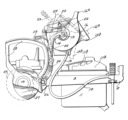
US Patent 1,619,380 (1928)
US patent 1,691,380, "Auxiliary Melting Pot for Linotype Machines," issued 1928-11-13 to George L. Curle. Filed 1917-09-17 as application serial number 220,263. Tilting auxiliary melting pot.
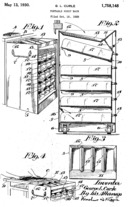
US 1,758,148. Curle. 1930. Portable Scoop Rack (Killout)
George L. Curle. Filed 1928-10-15. Issued 1930-05-13. Assigned to The Monomelt Company (Minneapolis). "Portable Scoop Rack." This is a portable cabinet holding scoops for collecting slugs to be fed into the Monomelt. It is designed in particular for the "killout" of dead forms. It seems to describe an item very much like the Monomelt part 32035, Killout Cabinet.

US 2,068,004. Curle & Thompson. 1937. Scoop System
George L. Curle and William H. F. Thompson. Filed 1930-05-09. Issued 1937-01-19. "Method and Apparatus for Handling Type Metal." Assigned to The Monomelt Company (Minneapolis). This expands the Monomelt Scoop rack described in US 1,758,148 to an entire system.
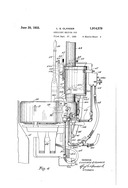
US 1,914,579. Olander. 1933. Monomelt for Monotype
Leonard G. Olander. Filed 1930-09-27. Issued 1933-06-20. "Auxiliary Melting Pot." This is an auxiliary melting pot as applied specifically to Monotype machines. I don't know either my Monotypes or my Monomelts well enough to know if this was ever produced.
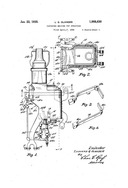
US 1,988,630. Olander. 1935. Converting Electric Pot to Gas
Leonard G. Olander. Filed 1934-04-07. Issued 1935-01-22. "Converted Melting Pot Structure." How to apply a gas Monomelt to an electric Linotype or Intertype pot and simultaneously convert the linecaster pot to gas.
E. B. Harding speaks well of it in his "Linecasting" column in Graphic Arts Monthly (June 1974): 107.
The Monomelt Parts Lists, Instructions, and other material reprinted here were published in the US without copyright notice at a time when such notice was required. They therefore passed into the public domain upon initial publication.
The Linotype Catalog No. 56 was published in the U.S. without copyright notice at a time when such notice was required. It therefore passed into the public domain upon original publication.
The Monomelt "Technical Bulletins" reprinted here were published in the US without copyright notice at a time when such notice was required. They therefore passed into the public domain upon initial publication.
The photographs of the Monomelt on my Elrod are copyright by us (David M. MacMillan and Rollande Krandall) and are licensed under the same Creative Commons "Attribution - ShareAlike" license as the rest of this Notebook.All portions of this document not noted otherwise are Copyright © 2009 by David M. MacMillan and Rollande Krandall.
Circuitous Root is a Registered Trademark of David M. MacMillan and Rollande Krandall.
This work is licensed under the Creative Commons "Attribution - ShareAlike" license. See http://creativecommons.org/licenses/by-sa/3.0/ for its terms.
Presented originally by Circuitous Root®
Select Resolution: 0 [other resolutions temporarily disabled due to lack of disk space]